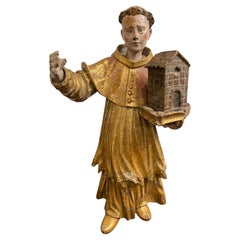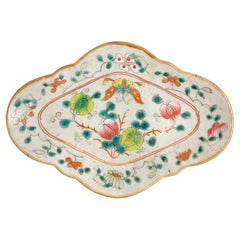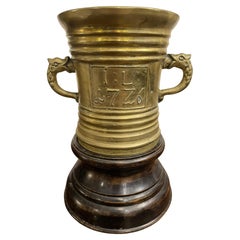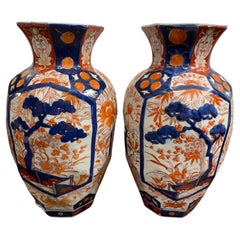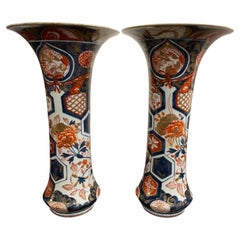Fine Classic Antiques Furniture
to
40
297
21
10
9
9
8
7
6
5
4
2
1
1
77
145
75
31
40
15
3
1
4
3
1
1
130
129
64
55
32
176
101
97
76
60
328
322
322
2
1
1
1
An Italian Polychrome Figure of a Saint, 18th Century
Located in ARMADALE, VIC
An Italian Polychrome Figure of a Saint, 18th Century
Provenance:
Private Western Australian Collection.
Description:
Clad in a double skirted gilt vestment, the figure holds a s...
Category
Antique 18th Century Italian Figurative Sculptures
Materials
Wood
A Royal Crown Derby Square Imari ‘383’ Dish, 19th Century
Located in ARMADALE, VIC
A Royal Crown Derby Square Imari ‘383’ Dish, 19th Century
Provenance:
Private Australian Collection.
Description:
The chamfered square dish applied with the ‘383’ design, otherwi...
Category
Antique 19th Century English Ceramics
Materials
Porcelain
$225 Sale Price
50% Off
A Chinese Wucai Plate, 19th Century
Located in ARMADALE, VIC
A Chinese Wucai Plate, 19th Century
Home decor, Interior design and collectibles.
Provenance: Private Victoria Collection.
Dimension:
Height: 4cm
Width: 20cm
Depth: 14cm.
Category
Antique 19th Century Chinese Qing Ceramics
Materials
Porcelain
$125 Sale Price
50% Off
A Dutch Brass Pestle, 18th Century
Located in ARMADALE, VIC
A Dutch Brass Pestle, 18th Century
initialled I.L. and dated 1776 to the body, together with a turned wooden stand, convex impression to the base of the urn. Home decor, Interior de...
Category
Antique 18th Century Dutch Jars
Materials
Brass
A Pair of Imari Vases, 19th Century
Located in ARMADALE, VIC
A Pair of Imari Vases, 19th Century
Provenance:
Private Australian Collection.
Description:
Each with an octagonal everted rim alternating between cobalt bands centred by two plu...
Category
Antique 19th Century Japanese Ceramics
Materials
Porcelain
$1,920 / set
A Pair of Japanese Imari Cornet Shaped Vases, 19th Century
Located in ARMADALE, VIC
A Pair of Japanese Imari Cornet Shaped Vases, 19th Century
Provenance:
Private Victoria Collection.
Description:
Each cornet shaped vase with two central chrysanthemum designs be...
Category
Antique 19th Century Japanese Ceramics
Materials
Porcelain
A Round Chinese Red and Black Lacquer Box, 19th Century
Located in ARMADALE, VIC
A Round Chinese Red and Black Lacquer Box, 19th Century
Provenance:
Private Old Melbourne Based Chinese Collection.
Description:
The shaped lid of equal proportions to the base an...
Category
Antique 19th Century Chinese Lacquer
Materials
Wood
$756 Sale Price
55% Off
A French Gilt-Metal Bureauplat, 19th Century
Located in ARMADALE, VIC
A French Gilt-Metal Bureauplat, 19th Century
Provenance:
Private Australian Collection Acquired in 1980s.
Description:
The shaped rectangular top inset with a tooled leather writ...
Category
Antique 19th Century French Louis XV Desks and Writing Tables
Materials
Bronze
A Spanish 17th Century Style Walnut Side Table, 18th Century
Located in ARMADALE, VIC
A Spanish 17th Century Style Walnut Side Table, 18th Century
Provenance:
Private New South Wales Collection.
Description:
The chamfered plank top over a frieze with a single draw...
Category
Antique 18th Century Spanish Side Tables
Materials
Walnut
A Spanish 17th Century Style Walnut Side Table, 19th Century
Located in ARMADALE, VIC
A Spanish 17th Century Style Walnut Side Table, 19th Century
Provenance:
Private Australian Collection.
Description:
With plank top over frieze of single drawer, centred by turned timber...
Category
Antique 19th Century Spanish Side Tables
Materials
Walnut
A Japanese Floral Imari Vase, 19th Century
Located in ARMADALE, VIC
A Japanese Floral Imari Vase, 19th Century
Provenance: Private Australian Collectio...
Category
Antique 19th Century Japanese Ceramics
Materials
Porcelain
A Japanese Fluted Imari Vase with Mark and Metal Cover, 19th Century
Located in ARMADALE, VIC
A Japanese Fluted Imari Vase with Mark and Metal Cover, 19th Century
Provenance:
Private Melbourne Collection.
Description:
The fluted Imari vase wi...
Category
Antique 19th Century Japanese Ceramics
Materials
Porcelain
A Japanese Imari Vase, 19th Century
Located in ARMADALE, VIC
A Japanese Imari Vase, 19th Century
Provenance: Private Australian Collection.
Description:
The body embellished with a repeating design of flowers and dragon cartouches united by ...
Category
Antique 19th Century Japanese Ceramics
Materials
Porcelain
A Japanese Imari Plate, 19th Century
Located in ARMADALE, VIC
A Japanese Imari Plate, 19th Century
Home decor, Interior design and collectibles.
Provenance: Private Australian Collection.
Dimension: Height: 4.5cm Diameter: 30cm
Category
Antique 19th Century Japanese Ceramics
Materials
Porcelain
$270 Sale Price
55% Off
A Japanese Fluted and Covered Imari Baluster Vase, 19th Century
Located in ARMADALE, VIC
A Japanese Fluted and Covered Imari Baluster Vase, 19th Century
Provenance: Private Australian Collection.
Description:
The domed co...
Category
Antique 19th Century Japanese Ceramics
Materials
Porcelain
A Chinese Qingbai Incised Flower Bowl, Song Dynasty, Ex Christie's
Located in ARMADALE, VIC
A Chinese Qingbai Incised Flower Bowl, Song Dynasty, Ex Christie's
Provenance: Private Melbourne Collection. Christie's Melbourne, 6/7/1999, lot 638.
Dimension: Height: 6.2cm Diam...
Category
Antique 15th Century and Earlier Chinese Ceramics
Materials
Porcelain
A Royal Crown Derby Imari ‘383’ Dish, Circa 1888
Located in ARMADALE, VIC
A Royal Crown Derby Imari ‘383’ Dish, Circa 1888
Provenance: Private Australian Collection.
Description:
The cylindrical dish applied with the ‘383’ design, otherwise...
Category
Antique Late 19th Century English Ceramics
Materials
Ceramic
A Pair of Japanese Imari Beaker Vases, 19th Century
Located in ARMADALE, VIC
A Pair of Japanese Imari Beaker Vases, 19th Century
Provenance: Private Brisbane Collection.
Description:
Each decorated with alternating panels of garden pavilio...
Category
Antique 19th Century Japanese Ceramics
Materials
Ceramic
A Pair of Japanese Lidded Imari Vases, 19th Century
Located in ARMADALE, VIC
A Pair of Japanese Lidded Imari Vases, 19th Century
Provenance: Private Melbourne Co...
Category
Antique 19th Century Japanese Ceramics
Materials
Porcelain
A Chinese Imari Style Plate with Chenghua Mark, 19th century
Located in ARMADALE, VIC
A Chinese Imari Style Plate with Chenghua Mark, 19th century
Provenance: Private Victoria Collection.
Description:
the central design comprising an unfurling blossom in hues of cob...
Category
Antique 19th Century Chinese Ceramics
Materials
Porcelain
A Pair of Japanese Imari Chargers, 19th Century
Located in ARMADALE, VIC
A Pair of Japanese Imari Chargers, 19th Century
Provenance: Private Australian Collection.
Description:
Each charger with a lobed border and comprising four fan-shaped panels, with...
Category
Antique 19th Century Japanese Ceramics
Materials
Porcelain
$2,270 / set
A Japanese Imari Charger, 19th Century
Located in ARMADALE, VIC
A Japanese Imari Charger, 19th Century
Provenance: Private Australian Collection.
Description:
The central floral basket motif within a border of hou-ou bird cartouches to a cobalt...
Category
Antique 19th Century Japanese Ceramics
Materials
Porcelain
A Japanese Imari Platter, Late 19th Century
Located in ARMADALE, VIC
A Japanese Imari Platter, Late 19th Century
Provenance: Private Melbourne Collection
Description:
With the conventional Imari palette, depicting six alternating floral and avian sc...
Category
Antique Late 19th Century Japanese Ceramics
Materials
Porcelain
A George I Walnut Bureau Cabinet, Early 18th Century
Located in ARMADALE, VIC
A George I Walnut Bureau Cabinet, Early 18th Century
Provenance: Priva...
Category
Antique 18th Century English George I Cabinets
Materials
Walnut
An English Brass Knights Boot Design Umbrella Stand, Circa 1930
Located in ARMADALE, VIC
An English Brass Knights Boot Design Umbrella Stand, Circa 1930
with weighted base, and spur detail. Stamped "Made in England." Home decor, Interior design and collectibles.
Provena...
Category
Vintage 1930s English Umbrella Stands
Materials
Brass
$645 Sale Price
50% Off
A Pair of Chinese Cloisonne Vases, Late 19th Century
Located in ARMADALE, VIC
A Pair of Chinese Cloisonne Vases, 19th Century
Provenance: Private Australian Collection.
Description:
Each on rolled foot with undulating standard rising to a tape...
Category
Antique Late 19th Century Chinese Qing Metalwork
Materials
Bronze
A Chinese Bronze Tripod Censer with Handles with Ming Xuande Mark, 19th Century
Located in ARMADALE, VIC
A Chinese Bronze Tripod Censer with Handles with Ming Xuande Mark, 19th Century
Home decor, Interior design and collectibles.
Provenance: Private Sydney C...
Category
Antique 19th Century Chinese Qing Metalwork
Materials
Bronze
A Pair of French Ormolu Mounted Rouge Marble Lamps, 18th Century
Located in ARMADALE, VIC
A Pair of French Ormolu Mounted Rouge Marble Lamps, 18th Century
Provenance: Private UK Collection.
Description:
Each rouge marble vasiform lamp ...
Category
Antique 18th Century French Table Lamps
Materials
Marble
A Scottish Victorian Silver Plate Retriever Cruet Set, Late 19th Century
Located in ARMADALE, VIC
A Scottish Victorian Silver Plate Retriever Cruet Set, Late 19th Century
Provenance: Private Australian Collection.
Description:
The cruet in the popular late 19th century form of ...
Category
Antique Late 19th Century Scottish Victorian Sheffield and Silverplate
Materials
Silver Plate
A Spanish Walnut Vargueno with Base, 18th Century
Located in ARMADALE, VIC
A Spanish Walnut Vargueno with Base, 18th Century
Provenance: Private Australian Collection.
Description: ...
Category
Antique 18th Century Spanish Cabinets
Materials
Iron
$15,500 / set
A Pair of Imari Hexagonal Jardinieres, 19th Century
Located in ARMADALE, VIC
A Pair of Imari Hexagonal Jardinieres, 19th Century
Provenance: Private Melbourne Collection.
Description:
The flat lip of each decorated with lotus cartouche panels, the tapering...
Category
Antique 19th Century Japanese Ceramics
Materials
Porcelain
A Spanish Walnut Vargueno, 18th Century
Located in ARMADALE, VIC
A Spanish Walnut Vargueno, 18th Century
Provenance:
From the private collecti...
Category
Antique 18th Century Spanish Cabinets
Materials
Walnut
A Spanish Giltwood Polychrome Decorated Figure of a Saint, Early 19th Century
Located in ARMADALE, VIC
A Spanish Giltwood Polychrome Decorated Figure of a Saint, Early 19th Century
Provenance: Private American Collection.
Description:
Depicted with a full head of curly hair and st...
Category
Antique Early 19th Century Spanish Religious Items
Materials
Wood
A Gujarati Timber and Pressed Tin Dowry Box, Early 20th Century
Located in ARMADALE, VIC
A Gujarati Timber and Pressed Tin Dowry Box, Early 20th Century
Provenance:
Private Australia Collection.
Description:
The modestly sized timber dowry box with rivete...
Category
Early 20th Century Indian Decorative Boxes
Materials
Tin
George II Lacquered-Brass and Chinese Coromandel Cabinet on Stand, 18th Century
Located in ARMADALE, VIC
A George II Lacquered-Brass and Chinese Coromandel Cabinet on Stand,
Cabinet and stand mid 18th Century, the panels early 18th Century
Provenance:
Walter, 5th Duke of Buccleuch...
Category
Antique 18th Century English George II Cabinets
Materials
Brass
A Pair of French Empire Style Ormolu and Bronze Candelabra, Late 19th Century
Located in ARMADALE, VIC
A Pair of French Empire Style Ormolu and Bronze Candelabra, Late 19th Century
Provenance: ...
Category
Antique Late 19th Century French Empire Wall Lights and Sconces
Materials
Bronze
An English Charles II Style Armada Chest, 18th Century
Located in ARMADALE, VIC
An English Charles II Style Armada Chest, 18th Century
Provenance: Private UK Collection.
Description:
The flat-topped chest bound in iron, with iron strap work punct...
Category
Antique 18th Century English Charles II Blanket Chests
Materials
Iron
A Spanish Silver-Plated Crucifix, 19th Century
Located in ARMADALE, VIC
A Spanish Silver-Plated Crucifix, 19th Century
Provenance:
Casa Santapola, S.L., Ronda (Málaga), November 2018.
Description:
Each crossbar with floral band terminating in f...
Category
Antique 19th Century Spanish Religious Items
Materials
Silver Plate
A Spanish Silver-Plated Altar Crucifix, 19th Century
Located in ARMADALE, VIC
A Spanish Silver-Plated Altar Crucifix, 19th Century
Provenance:
Casa Santapola, S.L., Ronda (Málaga), November 2018.
Description:
The crucifix with acanthus leaf protruding from t...
Category
Antique 19th Century Spanish Religious Items
Materials
Silver Plate
A Pair of Spanish Carlos II Carved Giltwood Wall Sconces, 17th Century
Located in ARMADALE, VIC
A Pair of Spanish Carlos II Carved Giltwood Wall Sconces, 17th Century
Provenance:
Private Collection of Jose Maria del Rey, September 2011.
Description:
Each with a floral moun...
Category
Antique 17th Century Spanish Wall Lights and Sconces
Materials
Wood
An Indian Silver Foil Overlaid Palaquin, Early 19th Century
Located in ARMADALE, VIC
An Indian Silver Foil Overlaid Palaquin, Early 19th Century
The open scroll and foliate embossed seat with a shaft to each end (one detached).
Provenance: Estate of Gol, Rajasthan,...
Category
Antique Early 19th Century Indian Furniture
Materials
Foil
$79,200 Sale Price
20% Off
A Small Oak and Pine Chest, Late 16th – Early 17th Century
Located in ARMADALE, VIC
A Small Oak and Pine Chest, Late 16th – Early 17th Century
Provenance:
Private Australian Collection.
Description:
The rectangular top with rounded carved foliate edges above a...
Category
Antique Early 17th Century European Blanket Chests
Materials
Oak, Pine
A Gilt-Bronze Group of the Infant Bacchus After Clodion, Late 19th Century
Located in ARMADALE, VIC
A Gilt-Bronze Group of the Infant Bacchus After Clodion, Late 19th Century
Proven...
Category
Antique Late 19th Century French Rococo Figurative Sculptures
Materials
Bronze
A Timber Group of Sleeping Silenus and Youth, Probably Dionysus, 17th Century
Located in ARMADALE, VIC
A Timber Group of Sleeping Silenus and Youth, Probably Dionysus, 17th Century
Provenance:
Acquired from a private collection, Paris c. 1980s.
Description:
Reminiscent of Flemis...
Category
Antique 17th Century French Baroque Figurative Sculptures
Materials
Wood
A Swiss Carved Black Forest Hunting Wall Plaque, Early 20th Century
Located in ARMADALE, VIC
A Swiss Carved Black Forest Hunting Wall Plaque, Early 20th Century
Provenance: Private New South Wales Collection.
Description:
The shield surround centred by a hi...
Category
Early 20th Century Swiss Wall-mounted Sculptures
Materials
Wood
$2,275 Sale Price
35% Off
One Chinese Black Lacquer Rectangular Lidded Jewelry box, Late 19th Century
Located in ARMADALE, VIC
One Chinese Black Lacquer Rectangular Lidded Jewelry box, Late 19th Century
Provenance: Private Melbourne Collection.
Dimensions: Width: 37cm Height: 10.5cm Depth: 20.5cm.
Category
Antique Late 19th Century Chinese Qing Lacquer
Materials
Wood
One Medal EXPOSITION, DE TOURS 1904
Located in ARMADALE, VIC
One Medal EXPOSITION, DE TOURS 1904
Provenance: Private Melbourne Collection.
Dimension: Height: 9 cm Width: 6 cm Depth: 2mm.
Category
Antique Early 1900s French Historical Memorabilia
Materials
Brass
One Commemorative Medal, EXPOSITION, PARIS, 1931
Located in ARMADALE, VIC
One Commemorative Medal, EXPOSITION, PARIS, 1931
Provenance: Private Melbourne Collection.
Dimension: Height: 8.5 cm Width: 5.5 cm Depth: 2mm.
Category
Vintage 1930s French Historical Memorabilia
Materials
Brass
$225 Sale Price
55% Off
One Medal EXPOSITION DE BRUXELLES, 1921
Located in ARMADALE, VIC
One Medal EXPOSITION DE BRUXELLES, 1921
Provenance: Private Melbourne Collection.
Dimension: Height: 0.2 cm Diameter: 7 cm.
Category
Early 20th Century Belgian Historical Memorabilia
Materials
Brass
A Bronze Mermaid Figural Bracket, 19th Century
Located in ARMADALE, VIC
A Bronze Mermaid Figural Bracket, 19th Century
Provenance: Private Australian Collection.
Dimension: Height: 33cm Depth: 19cm Width: 10cm.
Category
Antique 19th Century French Figurative Sculptures
Materials
Bronze
$765 Sale Price
50% Off
A Carved Rock Crystal Bowl, Early 20th Century
Located in ARMADALE, VIC
A Carved Rock Crystal Bowl, Early 20th Century
The bowl ovoid in form, the lid and body of equal proportions with a lobed surface and stylised Indian floral boarders, , atop a flat ...
Category
Early 20th Century Crystal Serveware
Materials
Rock Crystal
A Pair of Bronze Cherubs, Late 19th Century
Located in ARMADALE, VIC
A Pair of Bronze Cherubs, Late 19th Century
Two cast bronze cherubs, both with holes passing through each hand, suggesting the figures are intended to be carrying or hanging from an...
Category
Antique Late 19th Century French Figurative Sculptures
Materials
Bronze
$575 Sale Price / set
50% Off
A Vintage Chinese Brass Lock with Key
Located in ARMADALE, VIC
A Vintage Chinese Brass Lock with Key
The rectangular lock with incised maple leaves, blossoms and characters; together with a key
Provenance: Pri...
Category
Vintage 1970s Chinese Metalwork
Materials
Brass
$220 Sale Price
50% Off
A Chinese Brass Lock in the Form of a Turtle, Early 20th Century
Located in ARMADALE, VIC
A Chinese Brass Lock in the Form of a Turtle, Early 20th Century
The lock in the form of a turtle with moving legs, the lock mechanism beneath work...
Category
Early 20th Century Chinese Metalwork
Materials
Brass
A Cast Bronze Spout with Strignlete Pattern
Located in ARMADALE, VIC
A Cast Bronze Spout with Strignlete Pattern
Dimension: Height: 12cm Diameter: 6cm (Widest Point)
Category
2010s Australian Garden Ornaments
Materials
Bronze
$650 / item
A Cast Bronze Dolphin Spout
Located in ARMADALE, VIC
A Cast Bronze Dolphin Spout
Dimension: Height: 9.5cm Width: 25.5cm (Widest Point) Depth: 6cm (Widest Point)
Category
2010s Australian Garden Ornaments
Materials
Bronze
$1,045 / item
A Cast Bronze FW Spout with Small Florette and Egg and Dart Pattern
Located in ARMADALE, VIC
A Cast Bronze FW Spout with Small Florette and Egg and Dart Pattern
Dimension: Height: 15.3cm Width: 33cm (Widest Point) Depth: 10 (Widest Point)
Category
2010s Australian Garden Ornaments
Materials
Bronze
A Cast Bronze Tap with Fixed Handle
Located in ARMADALE, VIC
A Cast Bronze Tap with Fixed Handle
Dimension: Width: 14.5cm (Widest Point) Height: 12cm Depth: 5cm (Widest Point)
Category
2010s Australian Garden Ornaments
Materials
Bronze
$680 / item
A Large Cast Bronze FW Spout with Large Florette and Scolop Pattern
Located in ARMADALE, VIC
A Large Cast Bronze FW Spout with Large Florette and Scolop Pattern
Dimension: Width: 50cm (Widest Point) Height: 28cm Depth: 28cm (Widest Point)
Category
2010s Australian Garden Ornaments
Materials
Bronze
A Chinese Red Lacquer Baby Bath with Mark, Late 19th Century
Located in ARMADALE, VIC
A Chinese Red Lacquer Baby Bath with Mark, Late 19th Century
Provenance: Private Australian Collection.
Diamension: Height: 14cm Diameter: 42cm.
Category
Antique Late 19th Century Chinese Qing Lacquer
Materials
Wire
$455 Sale Price
30% Off
